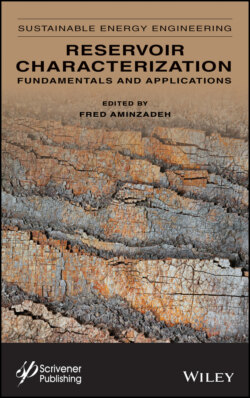Читать книгу Reservoir Characterization - Группа авторов - Страница 27
1.6.2 Reservoir Modeling
ОглавлениеQuantification of rock properties and the fluids in three dimensions is the process of reservoir modeling. The goal of reservoir modeling and fluid simulation is increased hydrocarbon fluid production with an increased rate of return. The 3D quantification is performed in a geo-cellular model that consists or reservoir geometry, lithology, porosity, permeability and initial fluid saturation. Integration of information from seismic data, cores, wireline logs and outcrops provide the quantification of the static reservoir model of the reservoir. A geological reservoir characterization is performed using a cellular facies model. Rock properties are assigned to model cells according to the defined facies. The geological models describe the flow layers that account for fluid and displacement phenomenon in the reservoir. It models the inter-well connectivity and continuity of flow units in the rock facies present within the reservoir architecture.
Reservoir fluid simulation is the quantification of fluid flow over time in the 3D reservoir model. The numerical model simulation and forecasts of reservoir performance is based on the geo-cellular static model. Reservoir simulation is performed to infer fluid flow behavior from a mathematical model. The forecast of reservoir performance is improved with increased accuracy in the geological model. Major decisions regarding the development and production plans for the reservoirs e.g., location and spacing of production and injector wells, depletion strategy, maximum production rates are based on the reservoir simulation. As hydrocarbons remaining in place become more difficult to recover, fluid movement in the reservoir needs to be more closely monitored. The location of remaining hydrocarbons must be known to plan injection schemes. Also, the manner in which injected fluids move and make contact with the target oil must be known in order to evaluate and, if necessary, correct the recovery project.
Static reservoir model provides a representation of the structure, thickness, lithology, porosity, initial fluids in the reservoir. As discussed in Section 1.5 on DRC, a dynamic reservoir model is a representation of the changes in fluid flow in the reservoir model that needs to be validated with reservoir performance data-pressure changes, production and injection rates. Rock properties defined in the reservoir rocks from 3D seismic interpretation include: Lithology, Porosity, Net pay thickness (or porosity volume), Fluid type and the respective fluid saturation, as well as the reservoir pressure. The heterogeneity within a petroleum reservoir has a profound influence on its production performance. Structural deformations, fractures, lithological variations, and diagenetic alternations all contribute to the creation or destruction of conduits and barriers to fluid flow through the reservoir matrix. Rock physics is a key component of analyzing the reservoir properties. It is important to monitor changes in the fluid flow or its composition during the producing life of the field. Figure 1.9 illustrates different components of reservoir modeling.
These integrated reservoir models are critical for forecasting, monitoring, and optimizing reservoir performance over the life cycle of the reservoir, from exploration, development, primary production and secondary/tertiary production. They will enable reservoir engineers to more accurately perform flow simulation studies, identify permeability flow-paths and barriers, map bypassed oil, and monitor pressure and saturation fronts in the reservoir. All of these are essential for effective reservoir management. Figure 1.10 shows how the original (static) geological or reservoir model based on the integration of geophysical data could be used to for reservoir simulation which in turn it can be used for reservoir monitoring and reservoir model updating.
Figure 1.9 Reservoir modeling process workflow. The process takes control of the data within its modeling framework and integrates the various types of data attributes. Courtesy: Roxar-Emerson.
Figure 1.10 Integrated reservoir modeling, fluid simulation update and reiteration by incorporating geophysical monitoring data. http://www.co2care.org/Sections.aspx?section=538.5.
In Part 7 of this volume, we will discuss Artificial Intelligence (AI) and Data Analytic (DA) can help address some of the remaining complexities associated with reservoir characterization results. For example, Nikravesh and Aminzadeh [12] reported on the past, present and future of AI in reservoir characterization. Twenty years later Aminzadeh [3], discussed how human and machine intelligence can be combined to improve characterization results. It is firmly believed that AI- and DA offer hope solve the issues related to the SURE Challenge discussed earlier.
